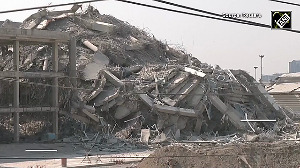Even as the Karnataka government is planning to invest Rs 3,716 crore (Rs 37.16 billion) over the next three years to provide dedicated railway connectivity to the new international airport near Devanahalli from the city, experts feel that the Indian Railways' network in and around the city can be utilised to ferry passengers at a fraction of the cost.
This network does not offer a perfect solution but an attractive intermediate one that can ease some of the load from the highway that will now be the only link and reduce journey time, by rail or road, to 50 minutes from the current 90 minutes or more.
As to why state politicians and government officials are not interested, a source familiar with the decision-making process said, "Please realise where the incentive lies. Spend Rs 3,000 crore (Rs 30 billion) or more on your own -- imagine the contracts that can be awarded -- or give the Railways Rs 100 crore (Rs 1 billion) or maybe less to do the job."
At present, two railway tracks (towards Hyderabad and Hindupur) run close to the new international airport, just 4 km from it. To use these tracks the government has to lay only 4 km of fresh track to connect to the new airport. In contrast, the high-speed link proposed by the state government will involved laying 34 km of fresh tracks.
Both existing tracks touch the Yelahanka railway station, which is well connected to all four corners of the city, including Whitefield, Sharjapur Road and even Electronics City, which hosts most of the IT offices.
The time required to travel between Electronics City to the new international airport can currently be approximately 80 minutes.
"However, we can augment the tracks for optimum use by trains and cut down the journey time to 50 minutes," sources in the South Western Railway (SWR) headquartered in Bangalore pointed out.
From the west (Rajajinagar and Malleshwaram), a track running from Bangalore City railway station through Malleshwaram joins Yeshwanthpura railway station, which is linked to Yelahanka railway station.
From the south, the Salem railway track running close to Electronics City, crosses Sharjapur Road and then bypasses Krishnarajapuram railway station (easily accessible from Whitefield), eventually connecting the Yelahanka railway station.
From the south west, the Mysore railway track passing through Kengeri and Vijayanagar connects to the Bangalore City station, which connects to Yalahanka and goes on to Hyderabad.
From the east, the Bangarpet railway line connects to Krishnarajapuram railway station, which connects to Yalahanka.
These apart, a railway track originating from the Cantonment railway station and passing through the city, connects to the Yeshwanthapura-Yelahanka railway track.
"It is essential to work on multiple fronts to improve connectivity to the airport in the short term. Solutions like a high-speed rail link will take time and are expensive," said V Ravichandar, former member, Bangalore Agenda Task Force.
There are two near-term fixes, he said. One, ask the Indian Railways for incremental investments to double tracks in places and run trains close to the airport. "The current railway tracks here are grossly underutilised," said Ravichandar.
Two, fix the road link by creating junction overpasses at 16 identified locations across the ring and approach roads.
According to a rough estimate prepared by SWR, a minimum investment of Rs 100 crore is required to strengthen the existing railway network to provide hassle-free connectivity to the new airport. The entire work can be completed within six months. But high-speed trains cannot be run on the existing railway tracks.
Another option is to lay a dedicated track next to the existing railway network, which will require in excess of Rs 3,000 crore investment and one year to implement.
The SWR, however, is not keen on taking up the project since the state government has not consulted them. "Intra-city transport issues do not come under the purview of Indian Railways. If the state government makes a formal request, we will take up the project," a senior SWR official added.
"We have the necessary infrastructure to complete the project on time. It will greatly reduce the vehicular traffic on National Highway 7 (existing connectivity to new airport)," he added.
The SWR was consulted five years ago by the state government on providing connectivity using the existing infrastructure.
"We had come to a conclusion that connectivity can be provided to the new airport since the railway network in the city touches all parts. We were ready to implement the project, but the government did not show any interest subsequently," the official stated.
Incidentally, the State Executive Committee, headed by Governor Rameshwar Thakur, had initially proposed to utilise the existing railway network to provide connectivity to the new airport. But the plan was dropped at the last minute due to various reasons.
One major reason was the journey time since high speed trains cannot be run on the existing railway network.
"It will take at least 50 minutes from the Cantonment railway station to reach the new international airport using the existing railway network. Our plan is to reduce the travel time to under 30 minutes by deploying high-speed trains," a top official in the state's Infrastructure Department said.
To run high speed trains by using the existing tracks, close to 45 km of new tracks will have to be laid next to the existing tracks.
"This was not acceptable to us since we have land in our possession to lay fresh track along a shorter route (34 km) that passed through the city. Besides, the gauge was an issue. Therefore, we went ahead with our own plan," the official noted.
Last week, the government floated a special purpose vehicle -- Bangalore Airport Rail Link Ltd (BARL) -- to design and implement a dedicated high-speed rail network between the city centre (BRV Grounds on M G Road) to the new international airport passing through Raj Bhavan Road, Bellary Road, Cauvery theatre junction, Mehkri underpass, Hebbal and Yelahanka.
Assuming this takes off in three years, it will still take two hours to go to the new airport from the main IT hub at Electronics City -- 90 minutes to get to the Cantonment station and 30 minutes by high-speed rail thereafter.







 © 2025
© 2025